

Bryce Freshwater
Pheochromocytoma symptoms, diagnosis and treatment by MedicineNet. Pheochromocytoma Tumor Symptoms What Are the Symptoms of Pheochromocytoma?
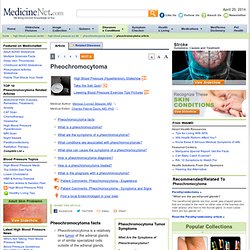
Someone with a pheochromocytoma usually has three classic symptoms, headache, sweating, and heart palpitations (a fast heart beat) in association with markedly elevated blood pressure (hypertension). Other conditions that may accompany these classic symptoms are as follows: anxiety, nausea, tremors, weakness, abdominal pain, and weight loss. Jco.ascopubs.org/content/25/15/1967.full.pdf. HealthTap. Carcinoid syndrome. Carcinoid syndrome occurs when a rare cancerous tumor called a carcinoid tumor secretes certain chemicals into your bloodstream, causing a variety of signs and symptoms.
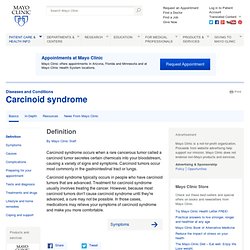
Carcinoid tumors occur most commonly in the gastrointestinal tract or lungs. Carcinoid syndrome typically occurs in people who have carcinoid tumors that are advanced. Treatment for carcinoid syndrome usually involves treating the cancer. Autonomic Carcinoid Symptoms. Colon cancer is a malignant lesion that forms in the colon, or the large intestine.

In 2009, the American Cancer Society reported 106,100 new cases of colon cancer in the United States. The types of colon cancer included adenocarcinoma, neuroendocrine tumors of the colon, and sarcoma and lymphoma of the colon. Over 95 percent of colorectal cancers are adenocarcinoma, according to the American Cancer Society. A benign or noncancerous polyp develops in the lining of the colon. This cluster of cells, called an adenoma, grows outward from the lining to the center of the colon. Neuroendocrine tumors grow more slowly than other cancers of the gastrointestinal system. Chromogranin A. Other names: CgA Chromogranin A is a protein, which is released by the neuroendocrine cells.

Neuroendocrine cells can contribute to benign and malignant tumours, including carcinoid tumours, insulinomas and phaeochromocytomas. CGAK/34641 Clinical: Chromogranin A, Serum. Useful For Suggests clinical disorders or settings where the test may be helpful Follow-up or surveillance of patients with known or treated carcinoid tumors Adjunct in the diagnosis of carcinoid tumors.
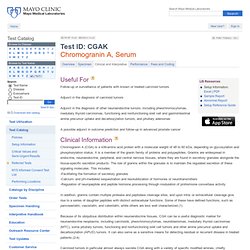
Diagnosis of Carcinoid Syndrome. Doctors often have difficulty diagnosing carcinoid syndrome in its early stages.
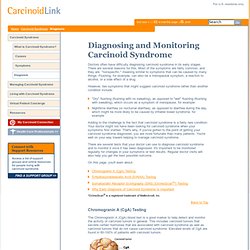
There are several reasons for this. Most of the symptoms are fairly common, and they are "nonspecific," meaning similar to symptoms that can be caused by many things. Flushing, for example, can also be a menopausal symptom, a reaction to alcohol, or a side effect of a drug. Chromogranin A. About Medscape Reference Medscape's clinical reference is the most authoritative and accessible point-of-care medical reference for physicians and healthcare professionals, available online and via all major mobile devices.

All content is free. The clinical information represents the expertise and practical knowledge of top physicians and pharmacists from leading academic medical centers in the United States and worldwide. The topics provided are comprehensive and span more than 30 medical specialties, covering: Diseases and Conditions. Study of Cga. CgA FAQ, NETs and CgA. Immune Stystem Dysregulation. Mitochondrial Dysfunction. The following symptoms may indicate that your child has mitochondrial dysfunction or a problem in energy production.
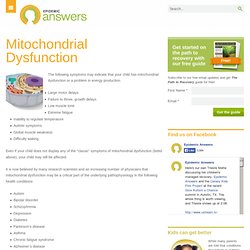
Large motor delaysFailure to thrive, growth delaysLow muscle toneExtreme fatigueInability to regulate temperatureAutistic symptomsGlobal muscle weaknessDifficulty waking Even if your child does not display any of the “classic” symptoms of mitochondrial dysfunction (listed above), your child may still be affected. It is now believed by many research scientists and an increasing number of physicians that mitochondrial dysfunction may be a critical part of the underlying pathophysiology in the following health conditions: AutismBipolar disorderSchizophreniaDepressionDiabetesParkinson’s diseaseAsthmaChronic fatigue syndromeAlzheimer’s diseaseSome gastronintestinal disorders, among others Click here (Mito Dysfunction in Health Conditions) to download an overview of the recent medical literature linking mitochondrial dysfunction to many well known illnesses.
Resources for Physicians. Immune Dysregulation. Although there are many environmental factors that contribute to chronic illness in children, one of the most important outcomes of all these environmental influences is a dysregulated immune system.
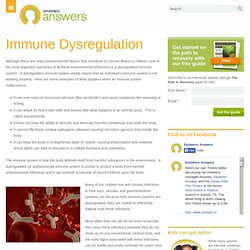
A dysregulated immune system simply means that an individual’s immune system is not working properly. Here are some examples of what happens when an immune system malfunctions: It can over-react to innocuous stimulus (like cat dander) and cause symptoms like sneezing or itching.It can attack its host’s own cells and tissues (like what happens in an arthritic joint). This is called autoimmunity.It does not have the ability to detoxify and eliminate harmful substances that enter the body.It cannot effectively combat pathogenic (disease-causing) microbes (germs!)
IgG and IgM. A.

IgG and IgM are short for immunoglobulin G and immunoglobulin M. Immunoglobulins are also known as antibodies and are substances produced by the body's immune system in response to foreign substances such as bacteria, viruses, fungi or other substances like animal dander or cancer cells. Antibodies combine or attach to the foreign substances, causing them to be destroyed or neutralised by the cells of the immune system. Antibodies are usually specific to each type of foreign substance e.g., antibodies produced in response to a tuberculosis infection attach only to tuberculosis bacteria.
Components that are too high. Chromogranin A. Chromogranin A (CGA) is one of the most important tests in the diagnosis of neuroendocrine tumors. Unfortunately, it is also one of the trickiest tests to interpret. I am asked very frequently by patients and colleagues on interpretation of CGA. CGA is a protein. It is produced in neuroendocrine cells and released into the circulation. CGA is metabolized to fragments and cleared by the kidney. Several issues need to be considered when interpreting the CGA results.
CGA can be elevated in benign and reversible conditions. The most common cause of elevated CGA in clinical practice is anti-acid treatment, especially proton pump inhibitors for acid reflux. Anion Gap. Components that are too low. Alkaline Phosphatase. Alkaline phosphatase is an enzyme involved in many chemical reactions in the body. Primarily concentrated in the liver and bones, alkaline phosphatase levels are generally evaluated as part of a liver function laboratory test. Elevated levels may indicate damage or disease of the liver, or bone diseases such as osteomalacia or Paget's disease. Although rare, low levels of alkaline phosphatase may occur and are generally due to genetic conditions or nutritional deficiencies.
Malnutrition can cause low levels of alkaline phosphatase in the blood. Deficiencies in vitamin B6, folic acid and vitamin C can lead to alkaline phosphate deficiencies as well as an excessive intake of vitamin D. Hypophosphatasia is a rare genetic disorder affecting bone and teeth development that occurs in approximately 1 in every 100,000 births, according to Orphanet. Several medical conditions may cause lower than normal levels of alkaline phosphatase.
GI Research. Gut Dysbiosis. One of the physical conditions in a body that can lead to immune dysregulation is something known as “gut dysbiosis.” The “gut,” or gastrointestinal system, simply refers to the long hollow tube that stretches from the tip of your tongue right down to your rectum. “Dysbiosis” refers to a state of imbalance among the colonies of microorganisms (bacteria, yeast, viruses, parasites, etc.) within your body. Gut flora. Description[edit] Over 99% of the bacteria in the gut are anaerobes,[3][4][11][14] but in the cecum, aerobic bacteria reach high densities.[3] The compositions of microbiota rely on several factors like host diet, colonization history, and immune status.[15] Some microbes are better suited to compliment specific metabolic enzymes over others. For example, Bacteroides change how they breakdown carbohydrates depending on if they received the right amount of certain substrates.[16] For instance, if humans began to fast extensively or discontinue feeding their bodies it would increase their intestinal permeability and in turn, hyper-stimulate the immune system and translocate the bacteria.
This speaks nothing, but havoc and destruction on one’s body.[17] Types[edit] Not all the species in the gut have been identified[3][4] because most cannot be cultured,[4][11][18] and identification is difficult. Enterotype[edit] Age[edit] You And Your Gut Flora. Grey zone food groups to eliminate The possible problems caused by vegetables of the nightshade family, nuts and seeds, fruits, dairy and egg whites have already been discussed in my article on dealing with autoimmune and digestive problems as well as my article about egg yolks, but a reminder is always in order. In short, in dealing with a gut or gut flora ailment, you should eliminate all these items for a while. When reintegrating them, the best way is to do it one by one to be able to tell if one of them causes problems.
Gut and Psychology Syndrome. Gut bacteria may influence thoughts and behaviour – Neurophilosophy. Google+ Inbox (1,935) - bfreshwater - Gmail. YouTube.